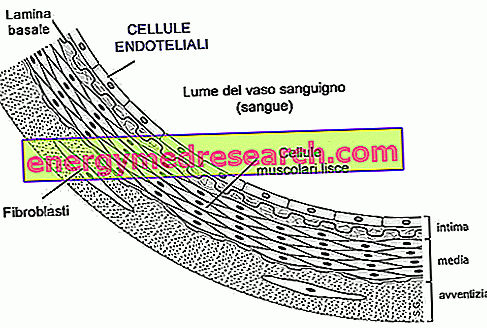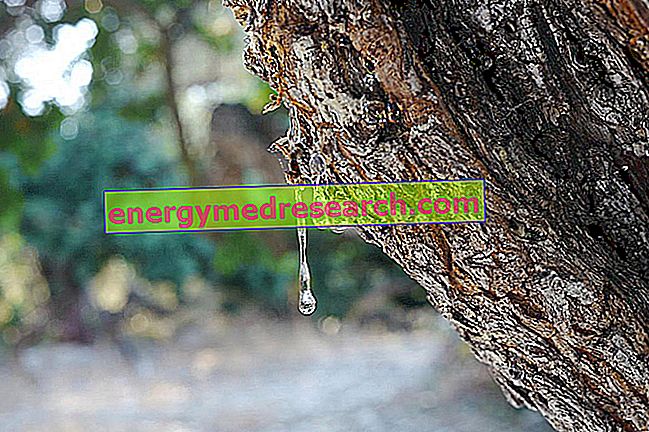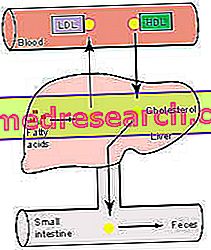The endothelium is the tissue that lines the inner surface of blood vessels, lymphatic vessels and the heart. It consists of a monolayer of flat and polygonal cells, called endothelial cells or endotheliocytes, which come into direct contact with the blood (or lymph) in their apical part; at the base, instead, they are anchored to the basal lamina and through it to the underlying tissues (medium or muscular frock and adventitious frock rich in fibrous tissue).
Endothelial cells are very thin and closely related to each other, so that the endothelial surface does not present any discontinuity (except for sinusoids); typically, they take an elongated shape towards the direction of blood flow, especially in the arterial vessels of greater caliber; in the smaller ones (capillaries), they are characterized by extreme thinness, with a thickness that in many cases does not exceed 0.2µm (at the capillary level there is also a lack of muscular and adventitious habits).
In general, the endothelium, although similar from a structural point of view, is functionally different depending on the organ in which it is found. The endothelium of the inner surface of the heart is called the endocardium.

Endothelial organ
Considering the endothelial tissue as a simple internal lining of the vessels is very simplistic, so much so that today the endothelium is considered a real organ, roughly composed of over a thousand billion cells that together weigh as much as the liver.
The endothelium can be considered an autocrine and paracrine organ in that it is able to secrete, in response to a great variety of signals, numerous chemical mediators that modify the behavior of both the cells themselves that produce them and those nearby. The result is a modulation of vascular tone and blood flow in response to nervous, humoral and mechanical stimuli.
Different and in some ways complex are the functions performed by the endothelium (and even more numerous are the mediators produced by its cells); let's see the main ones:
- Barrier function: the endothelium is similar to a semi-permeable membrane that controls the passage of substances from the extracellular liquid to the bloodstream and vice versa;
- Regulation of coagulation, fibrinolysis and platelet aggregation; balance of blood flow
- Control of adhesion and leukocyte infiltration
- Control of the proliferation of smooth muscle cells of the average tunic; modulation of tone, permeability and vessel structure: it plays a leading role in remodeling that is observed in hypertension, in stenosis after percutaneous coronary intervention and in atherosclerosis
- New blood vessel formation (angiogenesis)
- LDL oxidation and regulation of inflammatory processes
The chemical mediators produced by the endothelium can be distinguished in vasodilators, which increase the lumen of the vessels and also possess anti-proliferative, anti-thrombotic and anti-atherogenic action, and vasoconstrictors, which instead have the opposite function.
| MAIN ANTICOAGULANT MEDIATORS | MAIN PROCOAGULANT MEDIATORS |
|
|
Nitric oxide (NO) is the most important mediator of normal endothelial function: it has a powerful vasodilatory and inhibitory action against platelet activation, migration and proliferation of smooth muscle cells and adhesion and activation of white blood cells. Consequently the reduced production of nitric oxide has been associated with vascular diseases such as atherosclerosis, diabetes or hyperlipidemia.
Beyond intrinsic endocrine activity, we must not forget that the endothelium is itself the target of a multiplicity of neuro-hormonal signals. It also has mechanical "sensors" through which it constantly monitors the hemodynamic forces to which it is subjected. In response to these stimuli, endothelial cells act accordingly, releasing vasoactive substances, whose balance (between vasodilating mediators and vasoconstrictors) maintains vascular homeostasis.
Endothelial dysfunction
The functionality of the endothelium is so important for the health of the entire organism that it has pushed researchers to coin the term "endothelial dysfunction";

The factors that can cause functional damage to the endothelium are numerous and for the most part they are identified with cardiovascular risk factors (hypertension, hypercholesterolemia with altered LDL / HDL ratio, diabetes, overweight, smoking, low fiber diet and antioxidants, high calorie diet rich in animal fats and / or simple sugars, sedentary life ...). We have seen that subjects who present these risk factors also have a reduced release of prostacyclin and nitric oxide, probably due to the high levels of free radicals, as opposed to the prevalence of pro-coagulant substances such as the von Willebrand factor (vWf).
Regular physical activity and a balanced diet rich in antioxidants are able to reduce cardiovascular risk and improve the health of the endothelium and blood vessels in general; not surprisingly, we have seen and demonstrated that physical activity increases the bioavailability of nitric oxide and reduces the systemic inflammatory state. The cessation of smoking, the control of cholesterol and the intake of drugs that reduce insulin resistance in diabetics, blood pressure levels in hypertensives and hypercholesterolemia in subjects with hyperlipidemia, complete the picture of the most important measures to be taken to reduce endothelial dysfunction.



